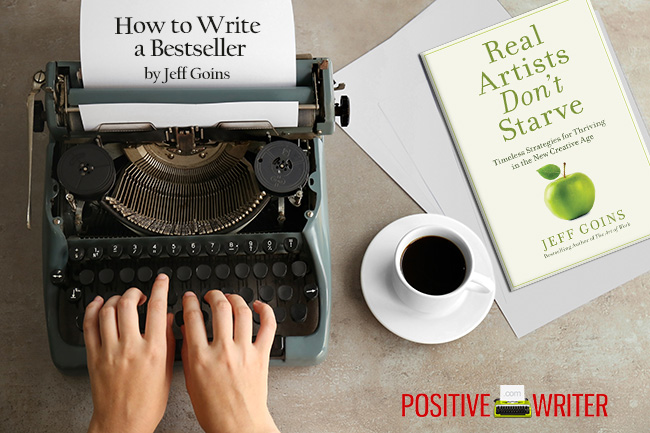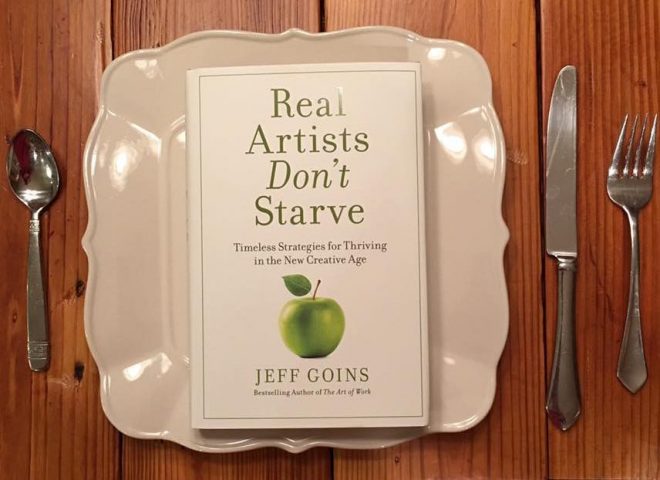Note: This is a guest post by best-selling author Jeff Goins whose recent book Real Artists Don’t Starve just hit The Wall Street Journal Bestsellers List. You can follow Jeff on Twitter @JeffGoins and visit him online at goinswriter.com.
One thing I’ve learned from publishing five books in the past five years, including my most recent work Real Artists Don’t Starve, is this: Writing books is hard work. And if you want a bestseller, it’s even harder.

Recently, there has been a lot of information on what it takes to launch a best-selling book. There are courses dedicated to this, promising you an instant bestseller. Bryan has written about the importance of a network in launching a book. I have published a number of articles myself on the topic, including lessons learned after launching my first bestseller and why being a best-selling author doesn’t mean what you think.
But little has been written about what has to happen before you can hit a bestseller list. Yes, there are the launch teams and the marketing plans. All of that is important. But long before all that, you must do something else:
To launch a best-selling book, you have to write a best-selling book.
The best marketing plan in the world won’t save a bad book. Sure, you might be able to launch it well, but it won’t lead to long-term success. And isn’t that what we writers want — to keep writing, keep creating our work for the long haul?
In this post, I want to share with you three strategies I learned from the past five books — including what I got wrong, what I’ll never do again, and how since I started applying these principles, every book I launch has been a bestseller (even when I didn’t try).
It takes three strategies to write not just a good book, but a bestseller. I did not come up with these ideas. As I write in [my most recent book](http://dontstarve.com), the best way to be creative is to borrow from other creative geniuses. “Steal like an artist,” as Austin Kleon says.
So here are my three best ideas, which I stole from other people, on how best-selling books are written.
1. Start with sticky statements
I learned this strategy from #1 New York Times best-selling author Lysa Terkeurst. The way she approaches writing her books, which each sell hundreds of thousands of copies, is by starting with a series of “sticky statements” as she calls them.
This begins with the big idea of the book. This may be the title or just the promise of the book. For example, my latest book, the promise was the title: Real artists don’t starve. The idea is that you don’t have to starve to create your best work, and the promise of the book is that I am going to show you how to do that.
Once you have the big idea, you then want to break the book up into a series of memorable statements that can easily be turned into takeaways for the reader. You can think of this as “tweetables” if you’d like, but the idea here is just to leave the reader with some immediately actionable items.
Hal Elrod whose self-published book the Miracle Morning has sold almost a million copies, generating over $70,000 a month in royalties, told me the secret to writing a bestseller is to make the content something your readers can apply the day after they read it.
2. Think of the book as a series of articles
Your book should be more than just a collection of essays. It should have an overall narrative arc or argument. But at the same time, you should be able to cut it up into a hundred different pieces and share it as many places as possible.
Best-selling author and media strategist Ryan Holiday told me this was the secret to how Tim Ferriss has sold so many copies of his book, The 4-Hour Workweek and subsequent titles. As he was writing the book, he thought of the it as a series of articles that he could immediately share with minimal editing, once the book was finished.
This is the easiest way to get mass media attention around your book without having to worry about too much self-promotion. The best marketing for a book is the content itself.
So as you write each chapter, each section, each paragraph, be thinking about how you could use this section as content on a blog post, in an article for a magazine, on a website, etc.
Think specifically about different target audiences and how you can craft content for the book that can be spun off as individual pieces that you can republish elsewhere.
When I was writing Real Artists Don’t Starve, I knew I wanted to market the book to writers, creatives, and entrepreneurs. So I made sure to include stories and examples that would speak to each of those audiences. Now that the book is finished, all I have to do is take one of those sections from the book and share it.
This will force you to make your ideas super clear, but it will also give you a treasure trove of marketable material as soon as the book is finished.

3. Don’t use time-sensitive material
In the 90s, my friend Michael Hyatt wrote a best-selling book about Y2K. Guess how many copies that book sells today? Not very many.
Since then, Michael has gone on to publish books on leadership, personal development, and building a platform. Contrasted with that first bestseller, these books continue to sell. Why? Because they’re filled with timeless material.
It’s one thing to hit a bestseller list once, it’s another to keep selling a lot of books. As an author, your goal should be the latter. That’s how you become a professional writer. You keep writing stuff that keeps selling.
One of the ways our books keep selling is that they don’t contain a bunch of dated material and examples. The best way to do this is to simply stay away from new material (avoid anything from the past 10-20 years).
Here’s what I mean:
- For illustrations, use a variety of ancient stories combined with more modern ones, but stay away from current events. You just never know what stories are going stick around; it’s better to use the ones that already have.
- For facts and figures, try to focus on the principles that have always been true, not just what seems in fashion today.
- For your argument, don’t try to say something brand new. That’s nearly impossible. Instead, resurrect an old idea that needs new attention. Bring back an ancient philosophy, as Ryan Holiday did with Stoicism. Or copy an old story structure, as Steven Pressfield did with The Legend of Bagger Vance, borrowing the plot of The Bhagavad Gita.
Current events and trendy topics are tempting to talk about. But for a writer, this is dangerous territory, because these new ideas can easily go obsolete within a few years of publishing the book. Instead, try to write timeless material that can be enjoyed year after year.
This is why many of history’s bestselling books are either novels, such as The Lord of the Rings or anecdote-driven self-help filled with timeless wisdom. Stories never go out of style.
So that’s it. Before you can launch a bestseller, you have to write one, and using these strategies should help.
If you want to learn more about creating your best work and making a living off it, be sure to check out my book Real Artists Don’t Starve. If you pick up a copy, I’d be super grateful. You can currently get $100 in bonuses at dontstarve.com if you buy the book in any format.
If you were to write a bestseller, what would you call it? Share your title in the comments.
